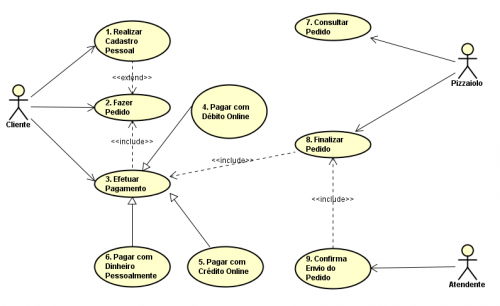Difficulty of abstraction in use cases
I am starting to study Use Cases and I have the following doubt:
Abstraction Difficulty: I often confuse when creating multiple use cases but that actually I would only need one, because that would represent everyone. Are there any tips so that one can know about what is and what is not a use case? In the example above, the use case " 3. Making payment "would be part of the use case" 2. Order"? If you do part, the details regarding payment methods (use cases 4,5 and 6) should be in the use case specification " 2. Order " demonstrating the step-by-step?
Thank you very much!
1 answers
Are there any tips so that one can know about what is and what is not a use case?
Use Case are used to identify and record the functional requirements of the system. Use case diagrams assist communication between analysts and the system by describing the scenario with features.
The use case diagram is represented by:
- actors;
- use cases;
- relationships between these element.
These relationships can be:
- associations between actors and use cases;
- generalizations between actors;
- generalizations,
extendsandincludesbetween use cases.
in the example above, the use case " 3. Making payment "would be part of the use case" 2. Order"?
In your diagram, 3 is part of 2. include is right. That's what he's for.
For you to understand better, on the UFCG website has this explanation:
Include : a relationship
includeof a use case A to a Use Case B indicates that B is essential to the behavior of A. It can also be said that B is_part_of a.Extend : a relationship
extendof a Use Case B to a use case A indicates that use case B can be appended to describe the behavior of A (not essential). The extension is inserted into an extension point of Use Case A. extension point in one use case it is an indication that other use cases may be added to it. When the use case is invoked, it it will check whether or not your extensions should be invoked. When you specifies bextendsA, the semantics are:
- Two use cases are defined: A and a extended by B;
- B is a variation of A. contains additional events, for certain conditions;
- Tem that be specified where B is inserted in a.
Use case utility
Although simple they are useful from communication with the customer to the generation of test cases. This is because, they do not require technical knowledge and the customer can understand the diagram effortlessly. In addition, new use cases generate new requirements and the merging of all scenarios is used to suggest the tests for each scenario.
References:
